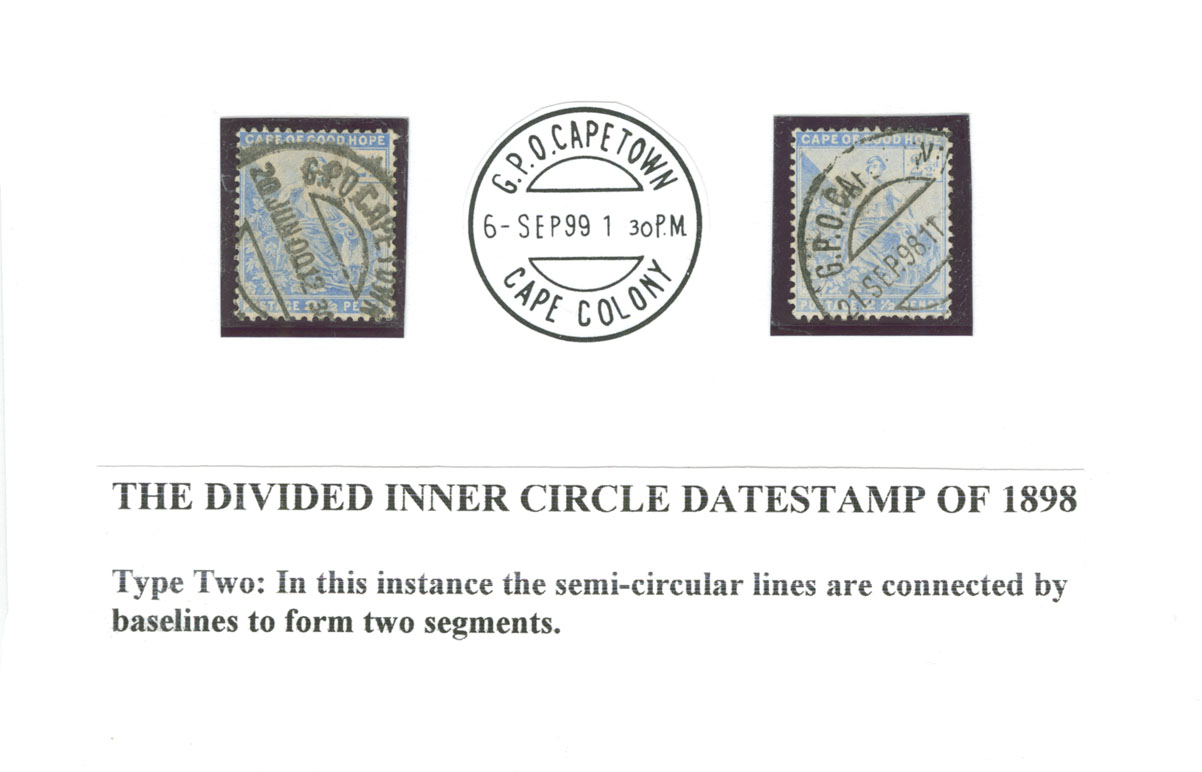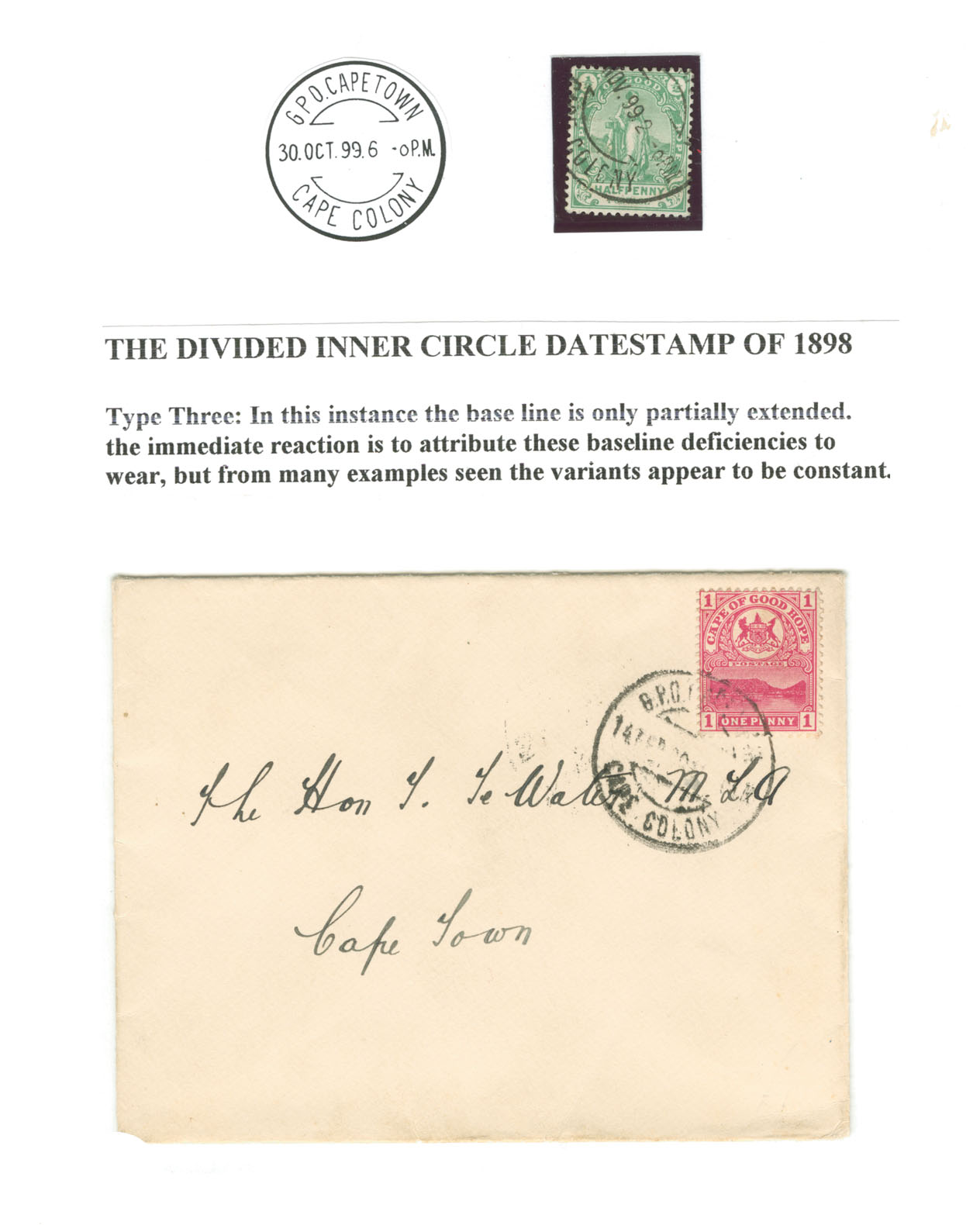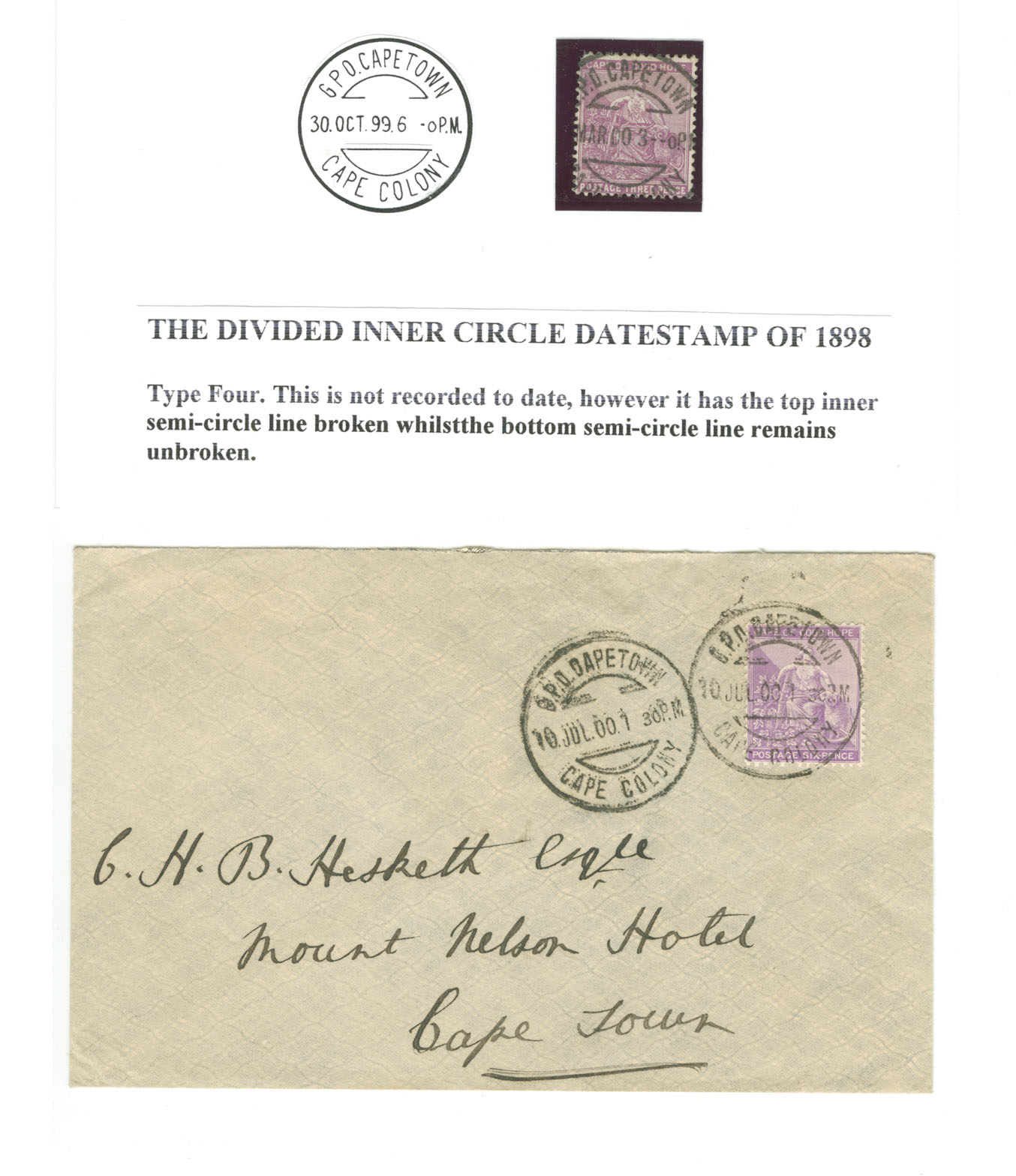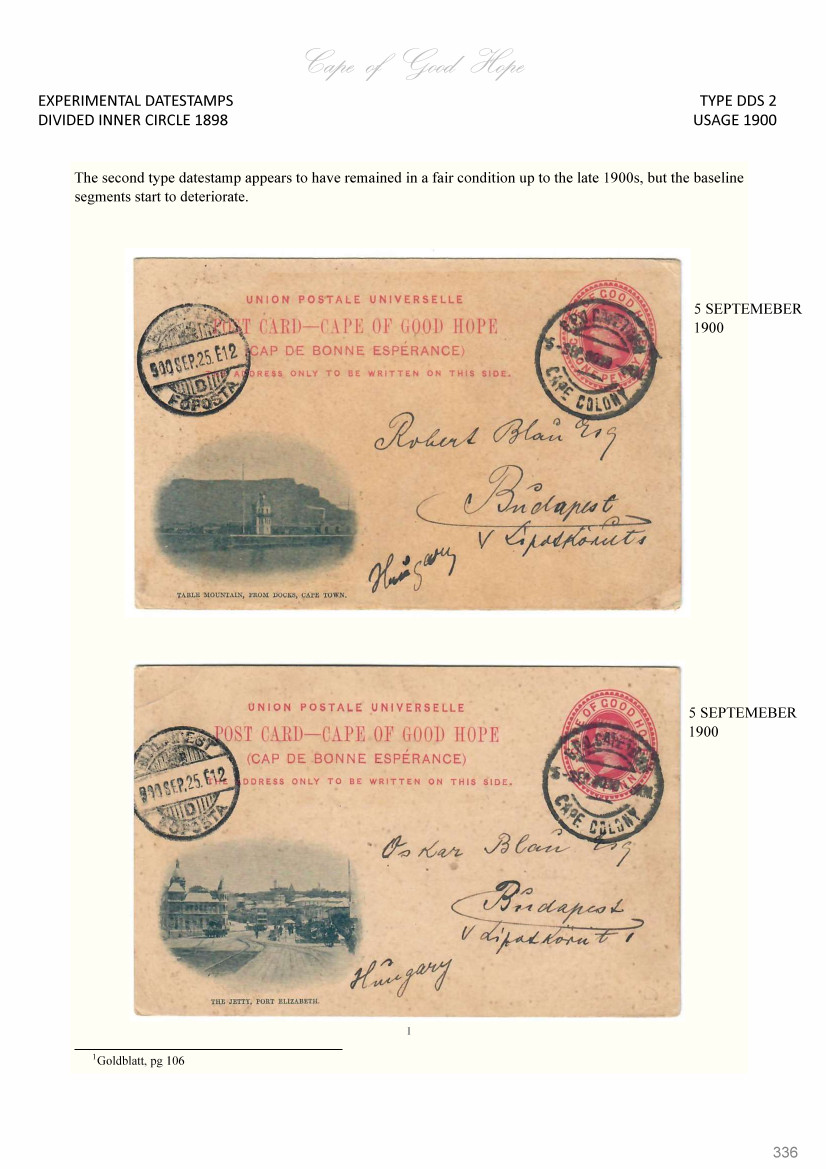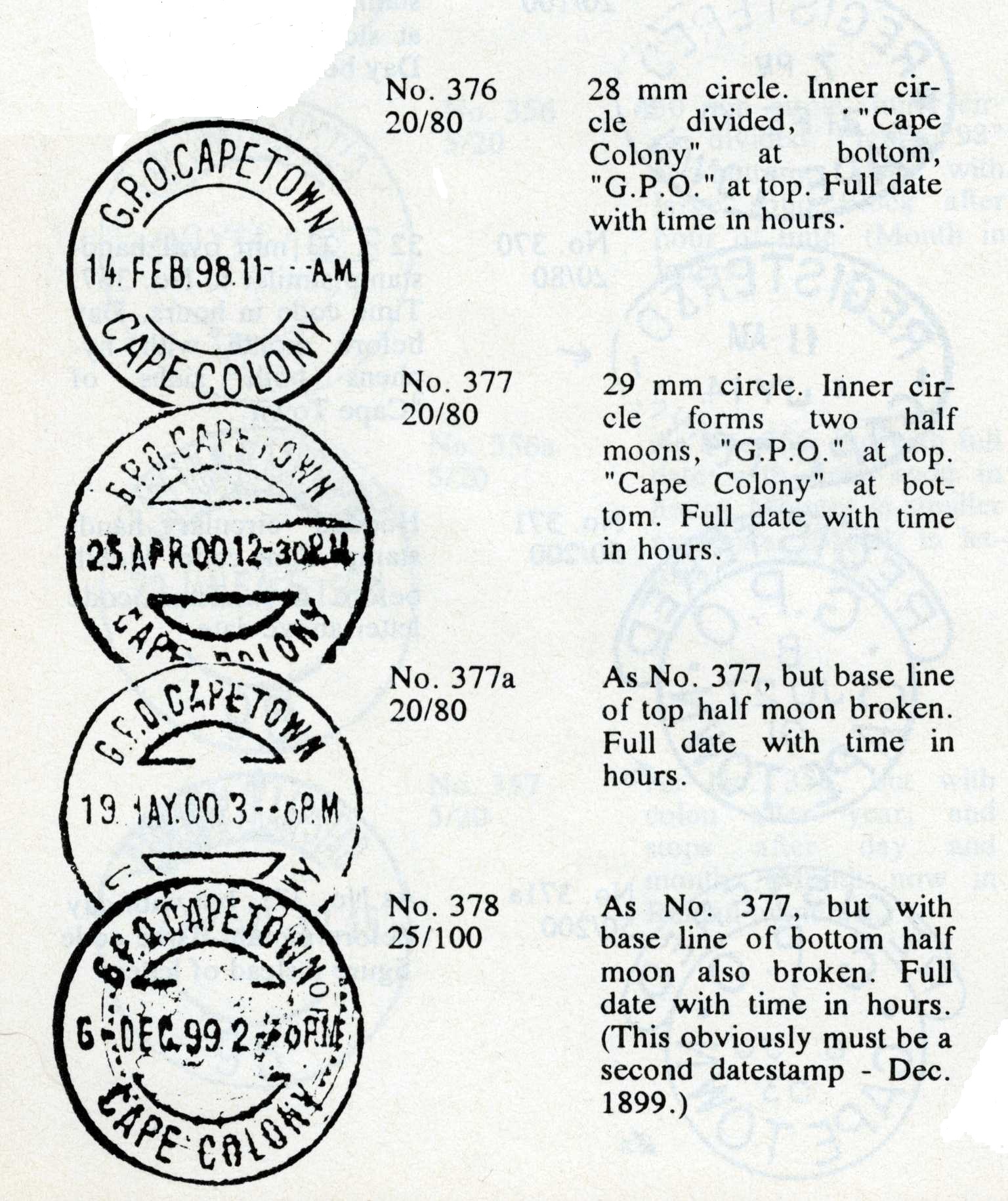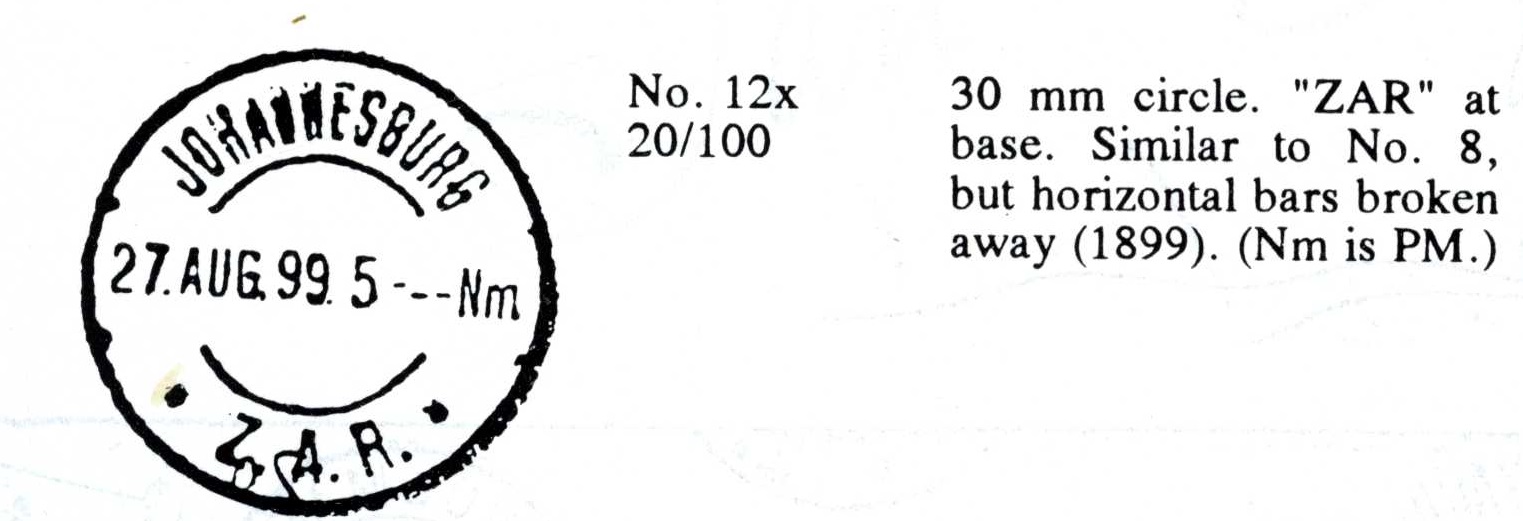Cape of Good Hope Divided Inner Circle Datestamp - 1898
Quote from yannisl on September 28, 2020, 10:43 amThe Divided Inner Circle Datestamp (denoted by Goldblatt as DDS), is not listed as an experimental postmark. However, in my opinion it has all the characteristics of an experimental handstamp, that is limited distribution, unusual design and a relatively short lifespan. I will start from the first two pages for this datestamp and then continue as we go along with postings for individual months, from January 1898 until 1900 (with a few gaps).
Goldblatt claims there were three types. I don't have many examples of the third type, which I speculate might not exist or was an adaptation of DDS 2, after 1901 where there is a gap in my collection.
Please add your contributions, specifically if you have related materials after 1901 and or better quality images. I also do not have Putzel handy, so if anyone can contribute with extracts from Putzel, so we can reference properly all philatelic authors that contributed to the research please assist.
For this particular experimental handstamp, I show earlier dates than those published. Please check if you have material from January 1898 and post them.
Personally I do not care match if I have ERD covers. I know these are short lived, but prefer to research the range of use and if the handstamp was used concurrently with others.
The Divided Inner Circle Datestamp (denoted by Goldblatt as DDS), is not listed as an experimental postmark. However, in my opinion it has all the characteristics of an experimental handstamp, that is limited distribution, unusual design and a relatively short lifespan. I will start from the first two pages for this datestamp and then continue as we go along with postings for individual months, from January 1898 until 1900 (with a few gaps).
Goldblatt claims there were three types. I don't have many examples of the third type, which I speculate might not exist or was an adaptation of DDS 2, after 1901 where there is a gap in my collection.
Please add your contributions, specifically if you have related materials after 1901 and or better quality images. I also do not have Putzel handy, so if anyone can contribute with extracts from Putzel, so we can reference properly all philatelic authors that contributed to the research please assist.
For this particular experimental handstamp, I show earlier dates than those published. Please check if you have material from January 1898 and post them.
Personally I do not care match if I have ERD covers. I know these are short lived, but prefer to research the range of use and if the handstamp was used concurrently with others.
Uploaded files:
Quote from Underbidder on October 3, 2020, 6:26 pmYou have some lovely material in this area. I dug these out and submit them in the hope that they bring something to the discussion.
You have some lovely material in this area. I dug these out and submit them in the hope that they bring something to the discussion.
Uploaded files:Quote from yannisl on October 3, 2020, 7:12 pmThanks for your posts. This particular datestamp interests me a lot and I have some more pages to post (doing some editing and need to scan them).
I am not too sure about Type 3 or Type 4 if they were really new datestamps or that they were misprints. If the datestamp got dirty or partially worn it tended to leave the same imprint on subsequent use. I have covers which I am hoping to post from first use to 1900 almost month by month. If there were new handstamps probably they came into use in late 1900-1901?
Here is a typical example, stamped probably within the same minute.
Thanks for your posts. This particular datestamp interests me a lot and I have some more pages to post (doing some editing and need to scan them).
I am not too sure about Type 3 or Type 4 if they were really new datestamps or that they were misprints. If the datestamp got dirty or partially worn it tended to leave the same imprint on subsequent use. I have covers which I am hoping to post from first use to 1900 almost month by month. If there were new handstamps probably they came into use in late 1900-1901?
Here is a typical example, stamped probably within the same minute.
Uploaded files:Quote from yannisl on October 3, 2020, 8:04 pmDDS 1 February-March 1898
The datestamp is hard to find in good condition. They show better on "soft cards".
DDS 1 February-March 1898
The datestamp is hard to find in good condition. They show better on "soft cards".
Uploaded files:Quote from yannisl on October 3, 2020, 8:06 pmDDS 1 June and October 1898
By August (see next post DDS 2 came into use).
This page shows use in June and October. By October the impression is very poor.
DDS 1 June and October 1898
By August (see next post DDS 2 came into use).
This page shows use in June and October. By October the impression is very poor.
Uploaded files:
Quote from yannisl on October 3, 2020, 8:10 pmDDS 2 August 1898
By August the second type appears. Now we have a possible ERD, at least on cover. I am sure one can find an earlier one on a stamp.
DDS 2 August 1898
By August the second type appears. Now we have a possible ERD, at least on cover. I am sure one can find an earlier one on a stamp.
Uploaded files:Quote from yannisl on October 3, 2020, 8:16 pmSeptember 1898-Dec 1899
I will scan and post images during this period as well. Just writing this so I will not forget.
In March 1899 another experiment also took place. This time the first machine canceller appeared.
September 1898-Dec 1899
I will scan and post images during this period as well. Just writing this so I will not forget.
In March 1899 another experiment also took place. This time the first machine canceller appeared.
Quote from yannisl on October 3, 2020, 8:34 pmA Failed Experiment?
This particular datestamp was brought into use with the only additional feature that it could mark time. However, on most of the surviving covers it is almost impossible to find covers where the time is impressed clearly. As such it failed.
The circles and the semi-circles, protected the lettering from wear and they are always readable even on very badly inked examples. I suggest that they were normally a few microns taller than the lettering and took the major part of the impact from stamping and hence would wear first so that they protected the lettering. This is an old technique from typographers, where rules on top of pages or around tables and figures protected more vulnerable parts.
The design and variants found worldwide use and in the attached page you will see CGH stamps cancelled by a similar German datestamp! Similar designs carried on until recent times.
A Failed Experiment?
This particular datestamp was brought into use with the only additional feature that it could mark time. However, on most of the surviving covers it is almost impossible to find covers where the time is impressed clearly. As such it failed.
The circles and the semi-circles, protected the lettering from wear and they are always readable even on very badly inked examples. I suggest that they were normally a few microns taller than the lettering and took the major part of the impact from stamping and hence would wear first so that they protected the lettering. This is an old technique from typographers, where rules on top of pages or around tables and figures protected more vulnerable parts.
The design and variants found worldwide use and in the attached page you will see CGH stamps cancelled by a similar German datestamp! Similar designs carried on until recent times.
Uploaded files:Quote from yannisl on November 13, 2020, 8:16 amThis is a puzzling cover. I am posting it here, but perhaps it should be on a separate thread for "Shipping Postmaster" mail. There are two puzzles for the postcard illustrated. The first did Goldblatt's DDS 3, really existed or was it a misprint? So far it is the only one I have seen and note it is not recorded by Frescura.
The second puzzle and this is more interesting is the paid amount on the card, which is 1s and 1 1/2 d. This item is ex: Robert Johnson, who noted on the write-up "The question as to why an extra 1s was paid remains open as it does not conform to a known late fee." I am of the opinion that this was a late-fee for the Ocean Post Office (just before sailing time).
I would welcome suggestions and or comments on both the postmark as well as my suggestion of a Late Fee. I am not too sure who the writer was, but obviously must have been a wealthy individual, as the postcard is addressed to Max Prince of Thurn and Taxis, who once hand the monopoly for almost all European mail.
This is a puzzling cover. I am posting it here, but perhaps it should be on a separate thread for "Shipping Postmaster" mail. There are two puzzles for the postcard illustrated. The first did Goldblatt's DDS 3, really existed or was it a misprint? So far it is the only one I have seen and note it is not recorded by Frescura.
The second puzzle and this is more interesting is the paid amount on the card, which is 1s and 1 1/2 d. This item is ex: Robert Johnson, who noted on the write-up "The question as to why an extra 1s was paid remains open as it does not conform to a known late fee." I am of the opinion that this was a late-fee for the Ocean Post Office (just before sailing time).
I would welcome suggestions and or comments on both the postmark as well as my suggestion of a Late Fee. I am not too sure who the writer was, but obviously must have been a wealthy individual, as the postcard is addressed to Max Prince of Thurn and Taxis, who once hand the monopoly for almost all European mail.
Uploaded files:
Quote from Bas PAYNE on November 14, 2020, 3:43 pmIn an earlier post, you asked if someone would post Putzel catalogue entries for Goldblatt DD01-DD03. Here they are, appended below.
Put 376 is Goldblatt DD01.
Put 377-8 are DD02-3, but make a different distinction, calling both distinctions into question; I will return to this in a second post.
These cancellers were a very considerable innovation in the Cape. Until 1898, in Cape cancellers the date was changed by removing "slugs" - small pieces of metal with a single number or letter at their end - from the canceller and replacing them with different slugs. In the divided inner circle date-stamps, the date and time are all in a single line, and were changed by rotating wheels, with numbers or letters round their circumference, on a single spindle. These were easier and quicker to change, and there was no risk of losing or rotating slugs.
In Transvaal, smaller wheel-change cancellers had been in wide use since 1894 (probably introduced from and made in the Netherlands or Germany); divided inner circle date-stamps, similar but not identical to the Cape Town divided inner circle date-stamps were brought into use in Johannesburg, Pretoria and other large offices in 1898: scans of Putzel catalogue entries for two examples, from Johannesburg, are attached.
One interesting detail of Goldblatt's DD01, as shown by the last attachment, is that the abbreviations for March and May aren't MAR and MAY, as would be expected, but MRT and MEI , adding to indications that the Cape was following Transvaal and probably using the same supplier. DD02-3 have MAR and MAY instead.
Date-stamps of basically the same type continued in use in Transvaal after the Boer War at many offices, while the Cape went back to slug-change cancellers until Union.
In an earlier post, you asked if someone would post Putzel catalogue entries for Goldblatt DD01-DD03. Here they are, appended below.
Put 376 is Goldblatt DD01.
Put 377-8 are DD02-3, but make a different distinction, calling both distinctions into question; I will return to this in a second post.
These cancellers were a very considerable innovation in the Cape. Until 1898, in Cape cancellers the date was changed by removing "slugs" - small pieces of metal with a single number or letter at their end - from the canceller and replacing them with different slugs. In the divided inner circle date-stamps, the date and time are all in a single line, and were changed by rotating wheels, with numbers or letters round their circumference, on a single spindle. These were easier and quicker to change, and there was no risk of losing or rotating slugs.
In Transvaal, smaller wheel-change cancellers had been in wide use since 1894 (probably introduced from and made in the Netherlands or Germany); divided inner circle date-stamps, similar but not identical to the Cape Town divided inner circle date-stamps were brought into use in Johannesburg, Pretoria and other large offices in 1898: scans of Putzel catalogue entries for two examples, from Johannesburg, are attached.
One interesting detail of Goldblatt's DD01, as shown by the last attachment, is that the abbreviations for March and May aren't MAR and MAY, as would be expected, but MRT and MEI , adding to indications that the Cape was following Transvaal and probably using the same supplier. DD02-3 have MAR and MAY instead.
Date-stamps of basically the same type continued in use in Transvaal after the Boer War at many offices, while the Cape went back to slug-change cancellers until Union.
Uploaded files:



